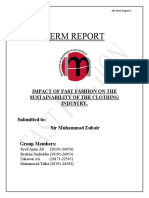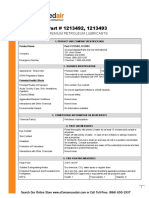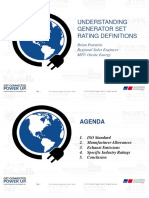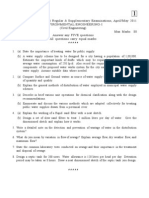Making Denim Eco Friendly
Making Denim Eco Friendly
Uploaded by
JUAN SEBASTIAN BUSTOS GARNICACopyright:
Available Formats
Making Denim Eco Friendly
Making Denim Eco Friendly
Uploaded by
JUAN SEBASTIAN BUSTOS GARNICAOriginal Title
Copyright
Available Formats
Share this document
Did you find this document useful?
Is this content inappropriate?
Copyright:
Available Formats
Making Denim Eco Friendly
Making Denim Eco Friendly
Uploaded by
JUAN SEBASTIAN BUSTOS GARNICACopyright:
Available Formats
Making denim eco-friendly
By Abir Chakrabarti, Alkesh Darji, Ketan Patel, Somes Bhaumik 28 January 2020
Among all the textile products, no other product has received such a wide acceptance as denim – especially blue jeans. Blue denim
jeans have been used extensively by people of all ages, classes and genders for well over 100 years. The production chain is optimised
for bulk production and with the capacity to meet this global demand. As a result, the overall environmental issues or impacts of denim
manufacture are significant. It is known that denim manufacturing has a negative environmental impact. Improvements in each step of
denim production offer potentially significant reductions in overall environmental impact as well as cost saving for the industry.
In this research article, the environmental issues caused by impacts of denim manufacturing /processing will be discussed, as well as the
sustainable solutions that have the potential to alleviate this negative impact.
ENVIRONMENTAL ISSUES OF DENIM PROCESSING
Denim is one of the most polluting industries with the textile industry; right from yarn dyeing through to garment washing. Even at post
consumer washing it bleeds which causes the contamination of water.
Indigo dye is part of the numerous marketed organic colourants used to colour denim. Effluents containing indigo dye make water toxic
and unfit for human and animal consumption. They also cause an imbalance in different aquatic ecosystem food chains.
Indigo obtained from plant source (Indigofera tinctoria) has been used for more than a century. Synthetic indigo dye was introduced in
1897. During the 1980s, indigo was combined with sulphur dye to acquire a new look and effects. Later in the 1990s, to widen the denim
colour range (apart from blue), sulphur dye was used separately to obtain colours such as black, brown, olive and burgundy. The use of
synthetic indigo and sulphur dyes pose a serious effluent problem. Indigo is one of the most valued and most globally widespread dyes of
antiquity and of the current era as it provides the blue for blue jeans.
Various researchers have identified the mutagenic effects of textile samples and wastewater from the textile industry. Their findings
showed that dyes used for textile finishing are mainly responsible for the mutagenic effects observed. Indigo dye had a mutagenic effect
on the bacterium Salmonella typhimurium (a pathogenic Gram-negative bacteria predominately found in the intestinal lume).
There is risk of disrupting the primary aquatic food chain when untreated indigo dye effluents are discharged into aquatic
systems. Researchers reported that indigo might cause a potential health risk through revealing toxic effects of other compounds or by
being a non-genotoxic carcinogen. If the effluent contains higher concentrations of indigo and indigoid dyes, it would be genotoxic
(damaging to the genetic information within a cell causing mutation).
Denim is made primarily with cotton, though it’s now often blended with synthetic fibres like polyester. Producing just 1 kilogram (2.2 Ibs)
of cotton can require up to 7,660 gallons of water, depending on where it’s grown. (In comparison, producing 2.2 Ibs of tomatoes requires
one-hundredth of that amount: 76 gallons.) A cotton crop consumes a lot of chemicals too: 16% of all insecticides are used on the plant,
and many of them pose significant health risks for farm workers and nearby residents.
DENIM DYEING
Three different dyeing techniques are used to dye the warp beam for denim weaving: rope dyeing, slasher dyeing and loop dyeing. More
than 95% of warp-dyeing for denim employs rope and slasher dyeing ranges.
The environmental impacts of denim processing can be classified into the following categories:
Water pollution: dyeing and finishing effluent discharge in water bodies
Page 1 of 12 pages
© 2019 World Textile Information Network. All Rights Reserved.
Air pollution: cotton dust, abrasives and chemicals found in air
Solid waste (sludge)
Ecological and toxicological problems caused by the direct discharge of denim wastewater in natural water bodies have been one of the
most significant water pollution problems. The presence of colour (indigo dye), dissolved solids (TDS), total suspended solids (TSS),
toxic (heavy) metals and residual chlorine in the effluent results in a high chemical oxygen demand (COD). The presence of organic
pollutants leads to a high biochemical oxygen demand (BOD).
DENIM WASHING
Denim washing is an aesthetic finish that is imparted to fabric to improve its softness and comfort. In addition, the fabric achieves a
different look such as a faded or worn-out appearance.
1. Stone washing
Pumice stone is used to stone wash denim garments. The stone gets abraded during the process and becomes powdered; part of it
remains in the liquor and part of it sticks to the garment. A huge amount of water is required for repeated washing cycles to remove the
deposited pumice from the denim. The effluent and pumice dust lead to environmental pollution.
2. Sandblasting
Sandblasting is a mechanical finish which uses sand containing silica. The minute silica dust spreads in the air it poses the risk of
causing serious respiratory diseases such as silicosis.
Microsanding is a finish that uses a series of rollers covered with abrasive paper or chemically coated abrasive paper. Chemically coated
abrasive papers means the abrasive papers are first coated with Carborundum, Aluminum Oxide, and Glass Fall and then used for the
required application. When the denim fabric is pulled over these rollers it results in a soft, raised surface and dulls the colour. The
abrasive material pollutes the environment.
3. Bleach washing
Chemical washing such as bleaching employs chemicals such as sodium hypochlorite or potassium permanganate. It is harmful to
human health and corrodes the stainless-steel drum of the bleaching machine. The effluent contains chlorinated organic substances
which cause severe pollution to the environment.
4. Acid washing
Acid washing uses both pumice stone and chemicals (sodium hypochlorite or potassium permanganate) for washing. It does not require
water but is still a pollutant because its effluent contains pumice dust and residual manganese, both of which are hazardous. Also, it
contains cotton fibre dust from the abrasion caused by pumice stones.
ECO DENIM
Fibre manufacturer Birla Cellulose has developed a complete range of denim look-alike options that look and feel like any conventional
niche cotton or lyocell denim range: Eco Denim. In the whole process, the technology does not use any dyes or chemicals. The wash-
down looks are also achieved without any chemical application. It is a sustainable solution for the denim industry that doesn’t
compromise on aesthetics.
Below are images of fabrics dyed using the new Eco Denim range:
Page 2 of 12 pages
© 2019 World Textile Information Network. All Rights Reserved.
Page 3 of 12 pages
© 2019 World Textile Information Network. All Rights Reserved.
Normal indigo
Page 4 of 12 pages
© 2019 World Textile Information Network. All Rights Reserved.
Sulphur bottom indigo top
Page 5 of 12 pages
© 2019 World Textile Information Network. All Rights Reserved.
Indigo bottom vat top
Page 6 of 12 pages
© 2019 World Textile Information Network. All Rights Reserved.
Page 7 of 12 pages
© 2019 World Textile Information Network. All Rights Reserved.
Enzyme wash
Page 8 of 12 pages
© 2019 World Textile Information Network. All Rights Reserved.
Page 9 of 12 pages
© 2019 World Textile Information Network. All Rights Reserved.
Enzyme bleach wash
Page 10 of 12 pages
© 2019 World Textile Information Network. All Rights Reserved.
Page 11 of 12 pages
© 2019 World Textile Information Network. All Rights Reserved.
Enzyme bleach stone wash
Advantages of Eco Denims over conventional denims:
Complete sustainable products as not used any indigo/chemicals/auxiliaries which are leading environmental pollutants
None use of any environmental polluting chemicals/pumice stones to get wash down, ie faded look effect
Oeko Tex 100 certified products
Highest effluent load saving compared to indigo effluent
Easy manufacturing route compared to conventional denim manufacturing
Zero staining on the any machineries as well as human body parts
No colour bleeding post any garment wash at home
Shrinking production timeline
Excellent washing and rubbing fastness: ratings of 4 whereas conventional achieves 2
Excellent shade repeatability
Excellent shade uniformity
Reproducible products even after a long time of interval
Highest first grade packing
Economical
By Abir Chakrabarti, Somes Bhaumik, Alkesh Darji & Ketan Patel, Textile Research & Application Development Centre (TRADC), Birla
Cellulose, Grasim Industries
Have your say. Tweet and follow us @WTiNcomment
Page 12 of 12 pages
© 2019 World Textile Information Network. All Rights Reserved.
You might also like
- Argumentative EssayDocument2 pagesArgumentative EssayLady Ronalyn ContrerasNo ratings yet
- Pantone - Color Trend 2021 - Recipes by Fiber V2.0Document15 pagesPantone - Color Trend 2021 - Recipes by Fiber V2.0JUAN SEBASTIAN BUSTOS GARNICA100% (2)
- Sustainable Fashion PPT 1 Aug 27 2020 Oct 10Document99 pagesSustainable Fashion PPT 1 Aug 27 2020 Oct 10Sunitha VichurNo ratings yet
- Dirty Secrets of Denim Washing and Sustainability FactorsDocument11 pagesDirty Secrets of Denim Washing and Sustainability FactorsSustainable Denim100% (3)
- Case Study On Textile and Leather IndustriesDocument12 pagesCase Study On Textile and Leather IndustriesArunkumar CHNo ratings yet
- Submitted By: Nitin Katoch Sabhyata MarwahDocument18 pagesSubmitted By: Nitin Katoch Sabhyata Marwahn.tNo ratings yet
- Green Story of Lyocell FibreDocument4 pagesGreen Story of Lyocell FibreKingson_786No ratings yet
- Impact of Textiles and Clothing Industry On EnvironmentDocument15 pagesImpact of Textiles and Clothing Industry On Environmentranjann349No ratings yet
- What Is Eco-Textile 2Document14 pagesWhat Is Eco-Textile 2Md. Mozammel Haque ShakibNo ratings yet
- Impact of Textile Production On EnvironmentDocument23 pagesImpact of Textile Production On Environmentchikoti vakyapriyaNo ratings yet
- AbstractDocument3 pagesAbstractgulshanaraliya55No ratings yet
- Can Waterless Dyeing Processes Clean Up The Clothing Industry - Yale E360Document6 pagesCan Waterless Dyeing Processes Clean Up The Clothing Industry - Yale E360chikoti vakyapriyaNo ratings yet
- Denim Sustainability Initiatives.Document5 pagesDenim Sustainability Initiatives.Sajib TonmoyNo ratings yet
- Reducing Textile FootprintDocument3 pagesReducing Textile FootprintMd.Abdul MannanNo ratings yet
- FAST FASHION API REPORT - Group 6Document8 pagesFAST FASHION API REPORT - Group 6syea amin aliNo ratings yet
- Green Textile Processing PDFDocument11 pagesGreen Textile Processing PDFGizele RaoNo ratings yet
- Eco Friendly Garment Finishes The Need of Hour For FashionDocument12 pagesEco Friendly Garment Finishes The Need of Hour For FashionAntotexNo ratings yet
- 21181004.shiblu (KIM-201)Document15 pages21181004.shiblu (KIM-201)RAKIB HOWLADERNo ratings yet
- Final Report API (Group 6)Document13 pagesFinal Report API (Group 6)syea amin aliNo ratings yet
- An Explanation of Bleach Wash On Denim Cotton - Journal of Textile Engineering & Fashion Technology, 87-89.Document5 pagesAn Explanation of Bleach Wash On Denim Cotton - Journal of Textile Engineering & Fashion Technology, 87-89.Tegar FirmanNo ratings yet
- Sustainable Processing in The Apparel Industry: BF Tech (Sem 3)Document16 pagesSustainable Processing in The Apparel Industry: BF Tech (Sem 3)Md. Hasan SheikhNo ratings yet
- Recycling Garments Fabric Wastes: Paper ID: EE-041Document6 pagesRecycling Garments Fabric Wastes: Paper ID: EE-041Arham BajwaNo ratings yet
- Waste Management in Dyeing UnitsDocument26 pagesWaste Management in Dyeing UnitsRITA SAHANo ratings yet
- Design To Reduce Chemical Impacts PDFDocument29 pagesDesign To Reduce Chemical Impacts PDFRayeddNo ratings yet
- EPM Mod5@AzDOCUMENTS - inDocument14 pagesEPM Mod5@AzDOCUMENTS - inRaunitNo ratings yet
- Waterless Dyeing TechniquesDocument4 pagesWaterless Dyeing TechniquesMohammed Atiqul Hoque ChowdhuryNo ratings yet
- Observations On Recycling Techniques For Textiles - A ReviewDocument6 pagesObservations On Recycling Techniques For Textiles - A ReviewTJPRC PublicationsNo ratings yet
- Factsheet Man-Made FibresDocument6 pagesFactsheet Man-Made FibresPrabaharan GunarajahNo ratings yet
- Nano Bubble Technology: A New Way To Sustainable Jeans FinishingDocument2 pagesNano Bubble Technology: A New Way To Sustainable Jeans FinishingElias KhalilNo ratings yet
- Ijser: Study On Waterless Chemical Effect On Indigo Rope DyeingDocument5 pagesIjser: Study On Waterless Chemical Effect On Indigo Rope DyeingDheerajNo ratings yet
- 3 Recycle and Reuse of Textile WasteDocument8 pages3 Recycle and Reuse of Textile WastegunashekarkalluriNo ratings yet
- Industrial Waste in Textile IndustryDocument3 pagesIndustrial Waste in Textile IndustryChetak YadavNo ratings yet
- Fast Fashion and How It Affects PollutionDocument4 pagesFast Fashion and How It Affects Pollutionmzapata2026No ratings yet
- Smart-Indigo: Brands Are Getting InvolvedDocument7 pagesSmart-Indigo: Brands Are Getting InvolvedAmir QayyumNo ratings yet
- Process of Textile IndustryDocument9 pagesProcess of Textile IndustryAkshata KoliNo ratings yet
- Washing With Natural AgentsDocument6 pagesWashing With Natural AgentsSheh 1234No ratings yet
- Brown University X TNFI Research Project Hadley Dalton, Madison Fitts, Ming-May HuDocument8 pagesBrown University X TNFI Research Project Hadley Dalton, Madison Fitts, Ming-May HuA SierraNo ratings yet
- Review of LitetatureDocument11 pagesReview of Litetaturemansi takNo ratings yet
- Innovations in Sustainable Textile Manufacturing A Guide For B2B BuyersDocument6 pagesInnovations in Sustainable Textile Manufacturing A Guide For B2B Buyerslabisa.clothesNo ratings yet
- Bleach Washing On DenimDocument4 pagesBleach Washing On DenimSabry AmorNo ratings yet
- Alaqmar - Digital and Ennvironmental TransformationDocument15 pagesAlaqmar - Digital and Ennvironmental Transformationalaqmar habibNo ratings yet
- Sustainable Processing in Garment IndustryDocument12 pagesSustainable Processing in Garment IndustryAmrita Mitra100% (1)
- Textile Waste in IndiaDocument12 pagesTextile Waste in IndiaThe United IndianNo ratings yet
- Syabila Alia Binti Sairuzi - 2021840902 - Assignment 2 PDFDocument12 pagesSyabila Alia Binti Sairuzi - 2021840902 - Assignment 2 PDFSYABILA ALIA SAIRUZINo ratings yet
- Reduce, Recycle, and ReuseDocument20 pagesReduce, Recycle, and ReuseAbhijit BanikNo ratings yet
- Recycling of Textile Waste Is The Best Way To Protect EnvironmentDocument7 pagesRecycling of Textile Waste Is The Best Way To Protect Environmentemigdio mataNo ratings yet
- Research Methodology On Fast Fashion and Waste WaterDocument48 pagesResearch Methodology On Fast Fashion and Waste WaterSNEHA100% (1)
- ConsequencesDocument2 pagesConsequencesORTEGA ANTONIO PAULINANo ratings yet
- Waste Management in Fashion IndustryDocument66 pagesWaste Management in Fashion IndustryChanchal JainNo ratings yet
- Sustainable Innovations in Textile Chemical ProcessesFrom EverandSustainable Innovations in Textile Chemical ProcessesNo ratings yet
- Current Affairs Mains 2019Document15 pagesCurrent Affairs Mains 2019srinivadNo ratings yet
- Term Paper - Id-1053 - Md. Raisul Islam ShamratDocument12 pagesTerm Paper - Id-1053 - Md. Raisul Islam ShamratNature Solution LimitedNo ratings yet
- English Assignment 2Document8 pagesEnglish Assignment 2thuw83774No ratings yet
- Project Report 1 Merged CompressedDocument39 pagesProject Report 1 Merged CompressedAnmol AgrawalNo ratings yet
- 1018pm - 31.EPRA JOURNALS 15479Document6 pages1018pm - 31.EPRA JOURNALS 15479Amiya SahaNo ratings yet
- Innovation Spotlight: Advanced DenimDocument5 pagesInnovation Spotlight: Advanced DenimagnberbcNo ratings yet
- Eco Friendly Textiles and Clothing: Dr. S. Kavitha, S. Geetha Margret SoundriDocument4 pagesEco Friendly Textiles and Clothing: Dr. S. Kavitha, S. Geetha Margret SoundriAryan WinnerNo ratings yet
- Water PollutionDocument30 pagesWater PollutionImtiaz AhmedNo ratings yet
- Textile Innovation ReportDocument9 pagesTextile Innovation ReportHector GuerreroNo ratings yet
- Dseu Pusa Campus AmanDocument17 pagesDseu Pusa Campus AmanSanjeev KumarNo ratings yet
- Use of Enzymes in Textile Wet ProcessingDocument6 pagesUse of Enzymes in Textile Wet ProcessingMohammed Atiqul Hoque ChowdhuryNo ratings yet
- Buying Eco Fabrics for Fashion Start-ups with Chris Walker: Overseas Apparel Production Series, #2From EverandBuying Eco Fabrics for Fashion Start-ups with Chris Walker: Overseas Apparel Production Series, #2No ratings yet
- Trimma FM6341HFDocument2 pagesTrimma FM6341HFJUAN SEBASTIAN BUSTOS GARNICANo ratings yet
- Ifabric Details Tests For Coronavirus On Protx2 FabricsDocument1 pageIfabric Details Tests For Coronavirus On Protx2 FabricsJUAN SEBASTIAN BUSTOS GARNICANo ratings yet
- Under Armour Develops Performance Face Mask: by Jessica Owen 18 June 2020Document4 pagesUnder Armour Develops Performance Face Mask: by Jessica Owen 18 June 2020JUAN SEBASTIAN BUSTOS GARNICANo ratings yet
- Biodegradation of Microbial and Synthetic Polyesters by FungiDocument10 pagesBiodegradation of Microbial and Synthetic Polyesters by FungiJUAN SEBASTIAN BUSTOS GARNICANo ratings yet
- New Dyeing Technology's Green Credentials: by AZM Anas, Jens Kastner, Keith Nuthall, Raghavendra Verma 12 August 2019Document4 pagesNew Dyeing Technology's Green Credentials: by AZM Anas, Jens Kastner, Keith Nuthall, Raghavendra Verma 12 August 2019JUAN SEBASTIAN BUSTOS GARNICANo ratings yet
- Schoeller Launches New Biodegradable Textiles PDFDocument2 pagesSchoeller Launches New Biodegradable Textiles PDFJUAN SEBASTIAN BUSTOS GARNICANo ratings yet
- Nan Ya Recicled PDFDocument20 pagesNan Ya Recicled PDFJUAN SEBASTIAN BUSTOS GARNICANo ratings yet
- Objective Testing: Clothing ComfortDocument68 pagesObjective Testing: Clothing ComfortJUAN SEBASTIAN BUSTOS GARNICANo ratings yet
- Repellent Finishes: Compiled by Tanveer AhmedDocument48 pagesRepellent Finishes: Compiled by Tanveer AhmedJUAN SEBASTIAN BUSTOS GARNICANo ratings yet
- Global Nylon Feedstock and Fibers Market: Trend Analysis and Forecast To 2022Document2 pagesGlobal Nylon Feedstock and Fibers Market: Trend Analysis and Forecast To 2022JUAN SEBASTIAN BUSTOS GARNICANo ratings yet
- Objective Testing: Clothing ComfortDocument68 pagesObjective Testing: Clothing ComfortJUAN SEBASTIAN BUSTOS GARNICANo ratings yet
- Thermal Performance of JacketsDocument7 pagesThermal Performance of JacketsJUAN SEBASTIAN BUSTOS GARNICANo ratings yet
- Carbon FootprintDocument7 pagesCarbon FootprintZaimon MaulionNo ratings yet
- MSDS Bionext 500Document4 pagesMSDS Bionext 500nghiamn8832No ratings yet
- MSDS Aceite Compresore CAMERONDocument3 pagesMSDS Aceite Compresore CAMERONmechiros100% (1)
- EBAU Cantabria InglesDocument7 pagesEBAU Cantabria Inglesusername4d6cNo ratings yet
- Reference No:: LEANNE'S FARM - San Jose Batangas CityDocument18 pagesReference No:: LEANNE'S FARM - San Jose Batangas CityJosephely EjercitoNo ratings yet
- Ecoclean Ausdrain EnviromoduleDocument18 pagesEcoclean Ausdrain EnviromoduleShamsul Bahrin SulaimanNo ratings yet
- UNL Professors Gates and Woldt Comments On Keystone XLDocument2 pagesUNL Professors Gates and Woldt Comments On Keystone XLhefflingerNo ratings yet
- App H - Evaluation of Sludge Dryer and Dewatering FacilitiesDocument77 pagesApp H - Evaluation of Sludge Dryer and Dewatering FacilitiesRajan BhosaleNo ratings yet
- The Status of Water Resources in West BengalDocument12 pagesThe Status of Water Resources in West BengalDebashish RoyNo ratings yet
- Benefits of Planting Trees: Why Trees Should Be Saved?Document10 pagesBenefits of Planting Trees: Why Trees Should Be Saved?Naina DubeyNo ratings yet
- Motor Grader ManualDocument56 pagesMotor Grader ManualTomislav Sabljak80% (10)
- Grease Unigear s5 Sae 90 API GL 5 (United Oil)Document4 pagesGrease Unigear s5 Sae 90 API GL 5 (United Oil)Ilham Ganjelan PantoNo ratings yet
- Treatment of Soap and Detergent Industry WastesDocument76 pagesTreatment of Soap and Detergent Industry Wastessumit kumar0% (1)
- Environmetal Poluution Grade2Document2 pagesEnvironmetal Poluution Grade2Dianne VillanuevaNo ratings yet
- Lagoon Design Guidelines, ManitobaDocument7 pagesLagoon Design Guidelines, ManitobaObaid Ur RehmanNo ratings yet
- Understanding Generator Set RatingsDocument48 pagesUnderstanding Generator Set RatingsdaneNo ratings yet
- Occupational Health ServicesDocument14 pagesOccupational Health ServicesHiral PatelNo ratings yet
- The Land Use, Land-Use Change, and Forestry Guidance For GHG Project AccountingDocument100 pagesThe Land Use, Land-Use Change, and Forestry Guidance For GHG Project AccountingRodolfo Barbosa YoungNo ratings yet
- r7320102 Environmental EngineeringDocument4 pagesr7320102 Environmental Engineeringslv_prasaadNo ratings yet
- Cop en Hag en Climate Change SummitDocument14 pagesCop en Hag en Climate Change Summitprashant1249No ratings yet
- Environmental Engineering Course HandoutDocument3 pagesEnvironmental Engineering Course HandoutHarshit BadhwarNo ratings yet
- A-19964-Article Text-1137735-1-4-20241028 - ReviewDocument8 pagesA-19964-Article Text-1137735-1-4-20241028 - ReviewrasendriyafarrelzahranNo ratings yet
- Reading and Writing: B-Progress in Medecine and Agriculture C-The Dangers of SmokingDocument6 pagesReading and Writing: B-Progress in Medecine and Agriculture C-The Dangers of SmokingVivine SaadNo ratings yet
- Use of Personal Protective Equipments: Manoj Kr. Ray SM (F&S)Document33 pagesUse of Personal Protective Equipments: Manoj Kr. Ray SM (F&S)mujeebtalibNo ratings yet
- Vennila Govindaswamy Department of Civil Engineering: Importance of Environmental Education FOR Sustainable DevelopmentDocument34 pagesVennila Govindaswamy Department of Civil Engineering: Importance of Environmental Education FOR Sustainable Developmentdanni1No ratings yet
- Perceived Tourism Impacts of Tourists On The EnvirDocument11 pagesPerceived Tourism Impacts of Tourists On The Envir21-50974No ratings yet
- Ventilation SystemDocument13 pagesVentilation SystemSaru BashaNo ratings yet
- 10th Geogrphy Lesson - 3 Water ResourcesDocument2 pages10th Geogrphy Lesson - 3 Water ResourcessheljanpdNo ratings yet
- AP Environmental Science Summary NoteDocument2 pagesAP Environmental Science Summary Noteichaewon557No ratings yet






































































































